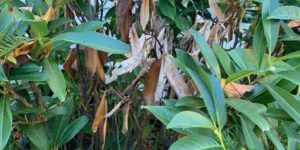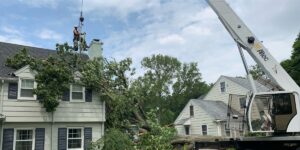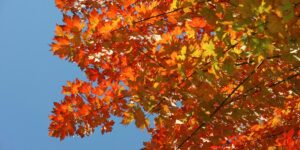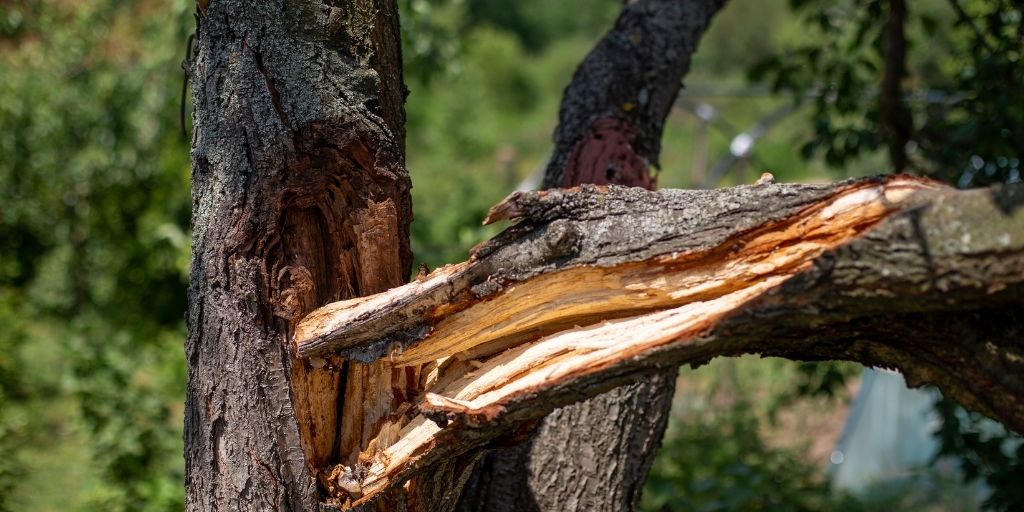What time of year is best for fertilizing trees and shrubs in New Jersey? What happens if you fertilize at other times of the year? Can you harm a tree if you give it fertilizer at the wrong time? And how do you know if a tree even needs to be fertilized?
Because of the depletion of organic matter and nutrients in urban and suburban soil throughout New Jersey, most landscape trees and shrubs will need fertilization at some point. But using the wrong fertilizer at the wrong time can do more harm than good.
In this article, we cover:
- the times of the year when you should fertilize trees and shrubs,
- what time of year to avoid fertilizing (and the exception to that rule),
- when a tree will and will not benefit from extra nutrients and how to tell when that is, and
- the one type of fertilizer you should never use on your trees.
What time of year should you fertilize trees and shrubs?
In New Jersey, the best time of year to fertilize trees and shrubs is in spring and fall. This is when your trees are using a lot of energy and are most likely to need extra nutrients for optimal health. It’s also when they’re best able to take up the nutrients provided by fertilizer.
Fertilize Trees in Early Fall
Before trees drop their leaves, they’re busy storing food energy to use during their winter dormancy and to prepare for next spring’s flush of growth. Fertilizing your trees in early fall ensures your trees will have enough energy reserves remaining after their summer growth and will be ready for next spring.
PRO TIP: Be careful not to fertilize too late in fall. That will stimulate new leaf growth that will be lost at the first frost. For a tree, this is a waste of precious energy reserves and could affect its growth the following spring.
Fertilize Trees in Spring
In spring, trees emerge from dormancy and use a lot of energy to push out new leaves and make flowers. Supplemental fertilization can help them produce stronger branches, greener leaves, and more flowers. And trees that weren’t in optimal health the previous fall will need the extra help after depleting their energy reserves over the winter.
What time of year should you NOT fertilize trees and shrubs?
There are two times of the year when you should generally avoid applying fertilizer: winter and summer.
Avoid Winter Fertilization
Avoid fertilization in winter when the visible parts of your trees are dormant.
Below ground, however, tree roots are still busy growing and taking up water (when the soil isn’t frozen). These delicate roots are easily burned by the concentrated mineral salts in fertilizers, right when they’re most needed by your dormant tree.
Unused, excess fertilizer will be washed away by winter rains and snowmelt instead of being taken up by your trees. This fertilizer runoff damages the health of our waterways and our potable water sources.
ALERT: New Jersey has a state ban on winter fertilizing if your fertilizer contains nitrogen or phosphorus. Both homeowners and professionals must respect this blackout period.
When NOT to Fertilize in Summer
By summer, most trees are making enough food energy through photosynthesis to support their growth. In general, fertilizers aren’t needed in summer if your trees or shrubs are healthy.
Over-fertilization in summer can stimulate excessive growth that you’ll need to prune off during the growing season. Plus, the new growth can be more easily burned by fertilizer salts, heat, drought, and hot summer sun. The end result is an overgrown tree that looks unsightly, is more likely to have health issues, and will need more maintenance.
When You SHOULD Fertilize in Summer
However, there are times when summer fertilization is necessary and appropriate (see below for signs that a tree needs extra help in summer). The key is to:
- use a gentle, slow-release fertilizer that won’t burn the leaves, and
- apply the fertilizer where the tree most needs it: at their root system.
The best way to fertilize in summer is to use compost tea soil injections. This ensures that nutrients are reaching your trees’ roots where they’re needed and the nutrients in the compost tea won’t overwhelm the tree.
CALL US TO LEARN MORE! – Our deep root injections with compost tea provide a gentle dose of targeted nutrients in the amount your trees need. And it’s safe to use on your trees during summer! In fact, it can make a world of difference for trees and shrubs showing signs of nutrient deficiency, in declining health, or with damaged roots or branches.
How do you know if your trees and shrubs need fertilization?
DO Fertilize if Your Tree Shows Signs of Nutrient Deficiency
Sometimes it’s easy to tell if your trees aren’t getting the range of nutrients they need. There are several common symptoms that usually signal nutrient deficiencies. They include:
- Yellow leaves
- Stunted growth
- Bare twigs and a patchy crown
- Drooping leaves and early leaf drop
- Stunted fruit and excessive fruit drop
These are all signs your trees don’t have enough energy or nutrients available to maintain vigorous growth.
PRO TIP: These common symptoms may also be signs of other tree health problems. A professional evaluation by a certified arborist is the best way to rule out insects, diseases, or environmental issues as the cause of your trees’ declining health.
DO Fertilize if a Soil Test Reveals Nutrient Deficiencies
If you think your trees and shrubs need fertilization, it’s important to know what nutrients they need and how much fertilizer to apply. Fertilizer runoff is a serious problem when too much fertilizer is used. And too much nitrogen and phosphorus cause problems for trees, such as decreased fruiting and preventing the uptake of other key micronutrients.
The best way to find out what nutrients your trees and shrubs need is to get a soil test from a qualified testing lab, such as the Soil Testing Lab at Rutgers. You’ll get information about nutrient levels in your soil, and instructions on how much fertilizer is needed to balance your soil’s fertility.
If you think the cost of a professional soil test isn’t worthwhile, we urge you to reconsider. You may find soil test kits in hardware stores and nurseries that are cheaper than a laboratory analysis. But their results are neither precise nor guaranteed, and professionals don’t use them.
DO Fertilize if Your Tree is Damaged or in Decline
Trees that have been damaged by storms, construction, pests or diseases, or over-pruning (including aggressive utility right of way pruning) will often benefit from supplemental fertilization, including in summer.
When a significant number of branches or roots have been broken or removed, trees aren’t able to produce enough energy or absorb enough nutrients to help them stay healthy. Plus, pests and diseases can make it more difficult for trees to thrive. The result is a noticeable decline in the number of leaves and increased yellowing.
Gentle fertilization, such as with deep root injections of compost tea, can help damaged and declining trees recover.
DON’T Fertilize Young & Newly Planted Trees
In general, young, and newly planted trees should not be fertilized. Fertilizers that stimulate growth can stress young trees whose root system and branch structure are too small to support fast growth.
Despite claims to the contrary, fertilization can be fatal for newly planted trees already struggling with transplant shock. Let your new tree settle in slowly for the first year without any supplemental fertilization; you’ll have better results later on.
DON’T Over-Fertilize Healthy Mature Trees
Similarly, mature trees and trees beginning their natural decline don’t benefit from heavy fertilization. Older trees have a much slower growth rate after they’re reached their mature size and they have an established and balanced system of roots and crown growth.
If you do need to fertilize mature trees, injections of compost tea tailored to your specific trees are recommended. This type of gentle, balanced fertilizing is one part of our tree health management plan and is designed to keep mature trees in optimal health.
We also recommend placing a layer of wood chip mulch around your trees to naturally add nutrients to the soil without fertilization.
DON’T Use Lawn Fertilizer on Trees & Shrubs
Lawn fertilizer is not tree and shrub fertilizer, so don’t be tempted to use it (or whatever fertilizer you have on hand) to treat your trees. Turfgrasses have different fertilizer requirements and growth habits than trees do, so don’t risk stressing your trees by applying the wrong mix of nutrients.
We’re Here to Help
If you’re not sure how to start fertilizing, when to do it, or what to use, give us a call. We can evaluate your trees and shrubs, get your soil tested, and design a comprehensive health maintenance program for your landscape plants.
As experienced arborists and tree care professionals, we love trees. In fact, we love trees so much that we offer our clients free deep root fertilization after they have us plant a new tree in their garden!








